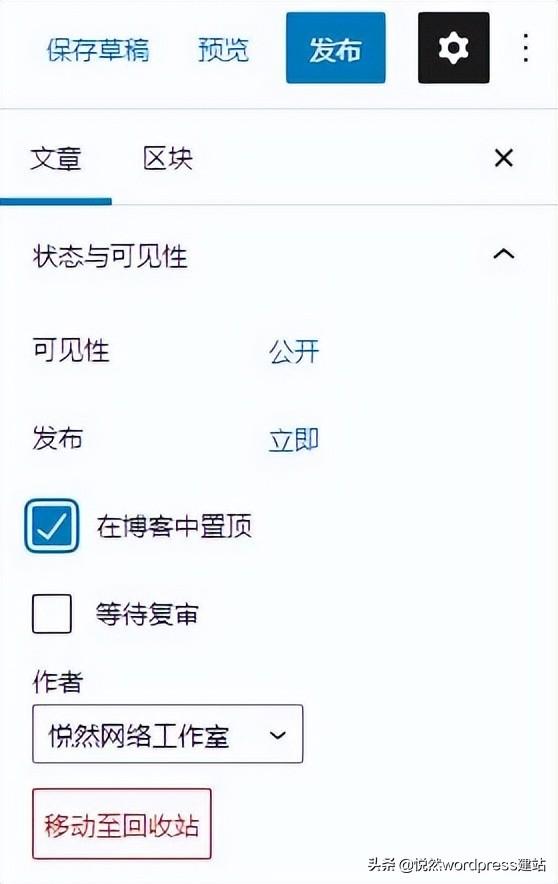Wordpress建站教程:调整Wordpress文章排序
作者:悦然wordpress建站(悦然建站)
(此处已添加小程序,请到今日头条客户端查看)
继续分享wordpress建站教程。今天给大家分享控制wordpress文章排序的方法。默认情况下wordpress网站的文章都是按时间排序的,这也比较符合文章更新的特点,一般情况下我们也没有必要特别处理。
可是对企业网站建设来说,我们难免会有一些特殊的要求,比如一些特别的产品或新闻需要把它放在前面。接下来悦然企业网站建设就给大家分享几个可以调整wordpress文章排序的方法。
1.时间控制
wordpress网站中默认情况是最新发布的文章是排在最前面的,所以我们可以通过修改时间的方法来控制文章排序。
比如你想让一篇文章排前面,那就把这个文章的发布时间按当前最新直接直接发布即可,如果你想让一篇文章排后台,那你只需要在发布文章时把发布时间调整靠后一些即可。

如果是已经发布的文章,你可以在文章列表中快速编辑,修改文章的发布日期就可以了。
温馨提示:通过修改时间来控制排序效果很好很直接,但是对网站SEO优化不利,所以这种方法尽量少用。
2.置顶功能

你可以在文章编辑页面直接选择让文章置顶,这样即使以后有新的文章发布,这篇文章也会显示在最前面。

同样你也可以给已发布的文章设置置顶,在文章列表中快速编辑,勾选置顶就可以了。
温馨提示:wordpress网站自带的置顶功能主要是针对博客网站中,但是很多企业网站因为都是二次开发过的,有些还取消也自带的配置功能,所以有些wordpress企业网站可能配置功能不会生效。此时可以尝试找第三方的置顶插件代替。
3.插件控制
前面的两种调整文章排序的方法都不太灵活,最理想的状态是我们可以像电脑桌面一下用鼠标来手动文章的位置,而这样的功能是可以实现的,只需要使用一个插件即可。

给大家推荐的插件是post-types-order,这款插件可以直接在wordpress插件中心,或者是在wordpress官网下载,软件可以免费使用,不过是英文的,但不影响使用。

启动插件之后你就可以直接手动文章排序了。
有些时候可能搜索不到post-types-order插件,我给大家提取了下载地址如下:
总结
关于wordpress网站文章排序就给大家介绍到这里,一般情况下自然排序就可以了,再配合置顶功能其实已经足够用了,如非必要还是不要随便去调整文章排序吧。
WordPress分类与标签等存档页实现置顶的方法
本文实例讲述了WordPress分类与标签等存档页实现置顶的方法。分享给大家供大家参考。具体分析如下:
在wordpress中默认能置顶文章就是只有首页了,如果我们希望分类/标签等存档页也能置顶文章我们需要二次开发.
现在参考wp-includes/query.php中首页置顶的代码,稍微修改一下,可以让分类页、标签页、作者页和日期页等存档页面也能像首页一样在顶部显示其范围内的置顶文章,把下面的代码放到当前主题下的functions.php中就可以了.
add_filter(\'the_posts\', \'putStickyOnTop\' );
function putStickyOnTop( $posts ) {
if(is_home() || !is_main_query() || !is_archive())
return $posts;global $wp_query;
$sticky_posts = get_option(\'sticky_posts\'); if ( $wp_query->query_vars[\'paged\'] <= 1 && is_array($sticky_posts) && !emptyempty($sticky_posts) && !get_query_var(\'ignore_sticky_posts\') ) { $stickies1 = get_posts( array( \'post__in\' => $sticky_posts ) );
foreach ( $stickies1 as $sticky_post1 ) {
// 判断当前是否分类页
if($wp_query->is_category == 1 && !has_category($wp_query->query_vars[\'cat\'], $sticky_post1->ID)) {
// 去除不属于本分类的文章
$offset1 = array_search($sticky_post1->ID, $sticky_posts);
unset( $sticky_posts[$offset1] );
}
if($wp_query->is_tag == 1 && has_tag($wp_query->query_vars[\'tag\'], $sticky_post1->ID)) {
// 去除不属于本标签的文章
$offset1 = array_search($sticky_post1->ID, $sticky_posts);
unset( $sticky_posts[$offset1] );
}
if($wp_query->is_year == 1 && date_i18n(\'Y\', strtotime($sticky_post1->post_date))!=$wp_query->query[\'m\']) {
// 去除不属于本年份的文章
$offset1 = array_search($sticky_post1->ID, $sticky_posts);
unset( $sticky_posts[$offset1] );
}
if($wp_query->is_month == 1 && date_i18n(\'Ym\', strtotime($sticky_post1->post_date))!=$wp_query->query[\'m\']) {
// 去除不属于本月份的文章
$offset1 = array_search($sticky_post1->ID, $sticky_posts);
unset( $sticky_posts[$offset1] );
}
if($wp_query->is_day == 1 && date_i18n(\'Ymd\', strtotime($sticky_post1->post_date))!=$wp_query->query[\'m\']) {
// 去除不属于本日期的文章
$offset1 = array_search($sticky_post1->ID, $sticky_posts);
unset( $sticky_posts[$offset1] );
}
if($wp_query->is_author == 1 && $sticky_post1->post_author != $wp_query->query_vars[\'author\']) {
// 去除不属于本作者的文章
$offset1 = array_search($sticky_post1->ID, $sticky_posts);
unset( $sticky_posts[$offset1] );
}
} $num_posts = count($posts);
$sticky_offset = 0;
// Loop over posts and relocate stickies to the front.
for ( $i = 0; $i < $num_posts; $i++ ) {
if ( in_array($posts[$i]->ID, $sticky_posts) ) {
$sticky_post = $posts[$i];
// Remove sticky from current position
array_splice($posts, $i, 1);
// Move to front, after other stickies
array_splice($posts, $sticky_offset, 0, array($sticky_post));
// Increment the sticky offset. The next sticky will be placed at this offset.
$sticky_offset++;
// Remove post from sticky posts array
$offset = array_search($sticky_post->ID, $sticky_posts);
unset( $sticky_posts[$offset] );
}
}
// If any posts have been excluded specifically, Ignore those that are sticky.
if ( !emptyempty($sticky_posts) && !emptyempty($wp_query->query_vars[\'post__not_in\'] ) )
$sticky_posts = array_diff($sticky_posts, $wp_query->query_vars[\'post__not_in\']);
// Fetch sticky posts that weren\'t in the query results
if ( !emptyempty($sticky_posts) ) {
$stickies = get_posts( array(
\'post__in\' => $sticky_posts,
\'post_type\' => $wp_query->query_vars[\'post_type\'],
\'post_status\' => \'publish\',
\'nopaging\' => true
) );
foreach ( $stickies as $sticky_post ) {
array_splice( $posts, $sticky_offset, 0, array( $sticky_post ) );
$sticky_offset++;
}
}
} return $posts;
} |
代码说明:
1、如果你想让存档页也都显示全部置顶文章,那么就删掉11-43行的代码;
2、如果不想在某分类页显示置顶文章,将第 3 行的
if(
//改成:
// abc是分类名称
if ( is_category( \'abc\' ) || |
3、如果不想某标签页显示置顶文章,将第 3 行的代码
if(
//改成:
// abc是标签名称
if ( is_tag( \'abc\' ) || |
4、如果不想某作者页显示置顶文章,将第 3 行的
if(
//改成:
// abc是作者昵称
if ( is_author( \'abc\' ) || |
5、以上代码只对主循环有效,如果你在存档页使用WP_Query或query_posts来获取文章列表,又像让这些列表顶部显示置顶文章,可以把第3行代码中的以下代码删掉(注意:可能会导致文章显示数量跟你设置的不一样):
代码如下:
置顶样式:如果你想给置顶文章添加样式,将以下代码添加到functions.php中,会给置顶文章添加一个名为 sticky 的class,具体的css代码,再自行自定义:
add_filter(\'post_class\', \'addStickyClass\' ,10,3 );
function addStickyClass( $classes, $class, $post_id ){
if( is_sticky() && is_category() && !isset( $classes[\'sticky\'] ) ){
$classes[] = \'sticky\';
}
return $classes;
} |
希望本文所述对大家的WordPress建站有所帮助。


